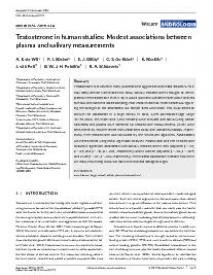Testosterone in human studies : Modest associations between plasma and salivary measurements
Summary
Testosterone is involved in many processes like aggression and mood disorders. As it may easily diffuse from blood into saliva, salivary testosterone is thought to reflect plasma free testosterone level. If so, it would provide a welcome noninvasive and less stressful alternative to blood sampling. Past research did not reveal consensus regarding the strength of the association, but sample sizes were small. This study aimed to analyse the association in a large cohort.
In total, 2,048 participants (age range 18–65 years; 696 males and 1,352 females) were included and saliva (using cotton Salivettes) and plasma were collected for testosterone measurements. Levels were determined by enzyme-linked immunosorbent assay and radioimmunoassay respectively. Free testosterone was calculated by the Vermeulen algorithm. Associations were determined using linear regression analyses.
Plasma total and free testosterone showed a significant association with salivary testosterone in men (adjusted β = .09, p = .01; and β = .15, p < .001, respectively) and in women (adjusted β = .08, p = .004; and crude β = .09, p = .002 respectively). The modest associations indicate that there are many influencing factors of both technical and biological origin.
Geachte bezoeker,
De informatie die u nu opvraagt, kan door psychotraumanet niet aan u worden getoond. Dit kan verschillende redenen hebben,
waarvan (bescherming van het) auteursrecht de meeste voorkomende is. Wanneer het mogelijk is om u door te verwijzen naar de bron
van deze informatie, dan ziet u hier onder een link naar die plek.
Als er geen link staat, kunt u contact opnemen met de bibliotheek,
die u verder op weg kan helpen.
Met vriendelijke groet,
Het psychotraumanet-team.
In : Andrologia, ISSN 1439-0272 | 50 | 1 | Februari | e12779
http://doi.org/10.1111/and.12779


